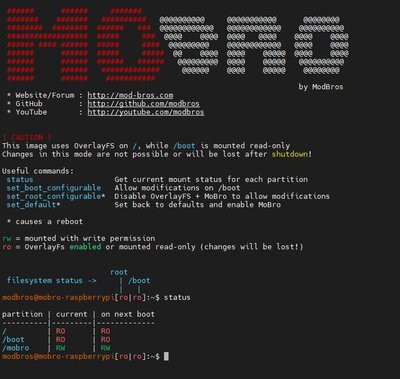In case your display is connected by the GPIOs rather than HDMI the display will initially be blank.
In order for the display to function you need to install the corresponding display driver.
For the most common displays we already included the drivers on the image so you won't need to search and download them.
Requirements
- Flashed and running Raspberry Pi connected to network
- GPIO Display connected to the Pi
- PC connected to the same network
Automatic installation
(v9 and newer)
Starting with version 9 of our custom Raspberry Pi image, the drivers for some of the most common displays are already included right on the image.
The can automatically be installed as part of the normal configuration process.
No SSH and no console required!
Detailed instructions can be found here: Setup
Manual installation
In order to install your display drivers manually on the Raspberry Pi you will need to connect to it by using SSH.
For the SSH credentials just use modbros as the username with password modbros.
(If your’re not familier just open a terminal (or command prompt on windows) and type: ssh modbros@[YOUR_RASPERRY_IP]
Depending on the version of the image you're using the required steps will slightly differ.
v12 of the image and newer
Starting with v12, the image makes use of OverlayFS.
As a consequence any configuration changes, driver installs etc. will not actually be written to the SD card and therefore will be gone upon the next shutdown/reboot.
To permanently install a display, we will first need to temporarily disable OverlayFS.
Once you logged onto the Pi via SSH, the welcome screen (to the right) will be shown which also introduces you to the commands required to manage OverlayFS.
Simply execute set_root_configurable now.
This will disable OverlayFS and also the MoBro service itself. To do this the Raspberry Pi will reboot once.
After the reboot we need to log back in via SSH.
By typing status you will see that the root partition is now listed as writable (RW)
Since most display drivers require to modify the config.txt file, we also need allow write operations to the boot partition. Simple execute set_boot_configurable to do that, no reboot required.
Checking the status again will show you that everything is writable now.
Now simple follow the regular instructions like on older versions (v11.1 and before) listed below.
After you're done with the driver installation, you will need to enable the MoBro service again. We also strongly recommend to switch back to enable OverlayFS again, as it greatly extends the SD cards lifespan and reduces the rist of data corruption.
To do so, simple log back in via SSH and execute set_default which will do that for you.
Note that enabling OverlayFS might take a minute (especially on the Pi Zero), so just give it a minute.
The Pi will reboot once its done.
v11.1 and older
Since our image is based on regular Raspberry Pi OS, the installation process does not differ from the regular one (apart from the different SSH username and password).
Simple check the manufacturers website (or manual that came with the display) for instructions on how to install the display driver for your specific display and follow those like you would with the official Raspberry Pi image.
Note: We can NOT guarantee that all displays will work, as there are just too many of them to test!